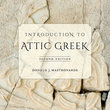 Accentuation Tutorial
Accentuation Tutorial

|
TOPICS Accent and Accent-Marking in Ancient Greek The Last 3 Syllables and the Accents Enclitics Persistent Accentuation |
(Enclitics are underlined in the following examples.) ἀγαθός τις, ἀγαθοί τινες, τῶν ἀγαθῶν τις, τῶν ἀγαθῶν τινες With accent on U of the preceding (head) word, that accent stays the same (no substitution of grave), and the enclitic (whether one or two syllables) is unaccented. τὸ ὅλον τε καὶ τὸ μέρος, ὁ στρατιώτης με ἀδικεῖ With acute on P of the preceding (head) word and a one-syllable enclitic, there is no change in the head word, and the enclitic is unaccented. τὸ ὅλον μεῖζον τοῦ μέρους ἐστίν, τὸ ὅλον ἐστὶν μεῖζον τοῦ μέρους With acute on P of the preceding (head) word and a two-syllable enclitic, there is no change in the head word, but the enclitic is accented on its second syllable, U (acute before punctuation, grave within the sentence). τὸ δῶρόν τε καὶ ἡ χάρις, δῶρά τινα μεγάλα With circumflex on P of the preceding (head) word and a one-syllable or two-syllable enclitic, an acute is added to U of the head word, and the enclitic is unaccented. ἔβαλλέ τις, ἔβαλλόν τινες With acute on A of the preceding (head) word and a one-syllable or two-syllable enclitic, an acute is added to U of the head word, and the enclitic is unaccented. |
||||